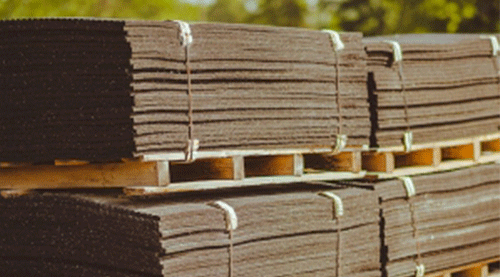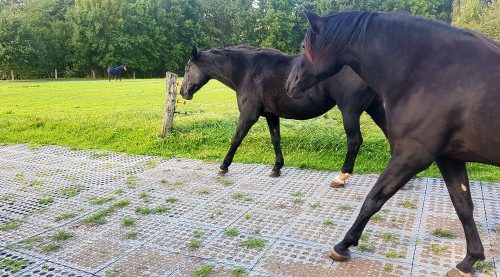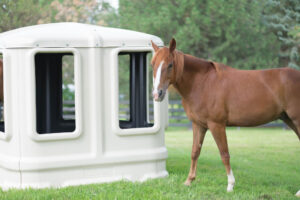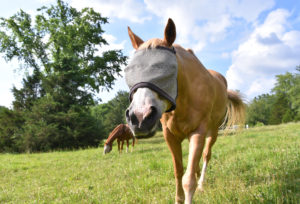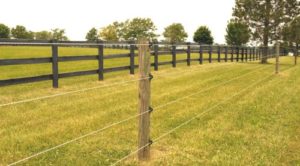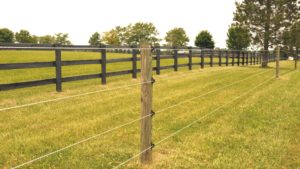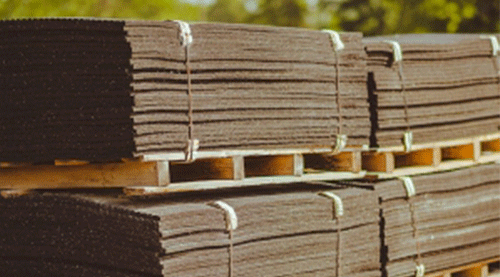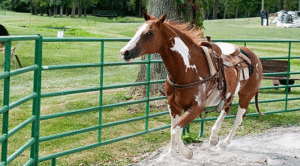
Mud Solutions Part 2 – Mud Management on Horse Farms
June 2020 – Lisa Kiley
Mud is something that as horse owners we have all experienced. The mild winters and wet springs make mud management on horse farms a difficult mess. Fortunately, there are some steps that can be taken so “mud season” isn’t a continual problem. Taking preventative measures to mitigate mud is a worthwhile investment for any equine property owner. As we start to come out of the mud season, this is the time to put mud solutions in place that will prevent mud year-round. Below, are some of the main areas to consider for mud management on horse farms:
1. Soil Types
Understanding how soil interacts with water is the first step to getting to the bottom of the mud equation. Porous soils, like sand, allow for the water to flow through and circulate, enabling the material to dry at a much faster rate. In the Midwest, we are much more likely to see clay in our soil. Clay is not as porous and holds onto moisture for longer amounts of time. Once it does dry, it can become rock hard. As a result, roots can have a difficult time growing and becoming established. This can lead to poor pasture growth without proper management practices.
2. Pasture Management
So what are some ways to manage pastures to avoid mud? First, placement of gate ways, water access, and feeding areas should be at higher points in the pasture. This will allow drainage of the water away from these areas keeping them dryer. Next, the forage in the field also needs maintenance to keep it at its best. Regular mowing, manure management, harrowing, seeding, and fertilizing as needed are important factors. However, managing the pasture itself is not enough. Rotational grazing, limiting access and proper stocking rates should be considered.
3. Rotational Grazing and Limiting Access
One of the most important aspects of maintaining mud free pastures is properly rotating and stocking pastures. In the spring, horses need to be limited from grazing on growing areas. This is not only because overeating spring grass can cause a horse to founder, but letting the grass grow longer will allow root establishment resulting in a healthier pasture. They should also be kept off areas that are overly wet where they are likely to damage grass. Provide rotational areas for the horses, so they do not over-graze a pasture. When grass is given time to grow, it will have more resilience against being turned to mud under hoof. Too many horses in one space will exhaust the grass resources quite quickly, create compaction and leave the barren ground susceptible to mud.
4. Heavy Use Areas
Keeping horses off grass pastures does not mean that they must be kept cooped up inside their stalls. A key aspect to pasture management is creating a ‘sacrifice’ area for situations when it’s best to keep horses off the pasture. While this area may be high traffic and lack grass, it shouldn’t mean that horses have to stand hock deep in mud. Ideally, this space should be prepared to handle wet conditions without compromising the footing. This can mean adding screenings, sand, or stone and possibly a geotextile layer beneath. There are other options that do not require surface prep, like mud grids that can be laid atop existing mud. These grids may be a bit more of an investment to start, but they are easy to install and can be moved as needed. As a result, they offer a long term solution that can be used wherever needed on the facility.
5. Control Water Flow
If you find an area where water is pooling and creating a muddy mess, consider adding an eve trough or rerouting the flow of water to an area better suited for drainage. In many cases, rainwater can be collected and used for watering gardens, routed to a pond or water feature, or in some cases even to water livestock. For more information on this, check with your state natural resources department for regulations on rainwater usage.
Interested in finding out more about soil testing, pasture management and rotational grazing? Check with your local extension office for more information and resources. Questions about what mud management products you can put into practice? Cashmans Horse Equipment is happy to help.
Links for State Resources
Michigan – MSU Extension Office
Michigan Department of Natural Resources
Ohio Department of Natural Resources
Cashmans Helpful Resources
Recommended For You
-
-
Stable Ground Mud Solution
$17.50





